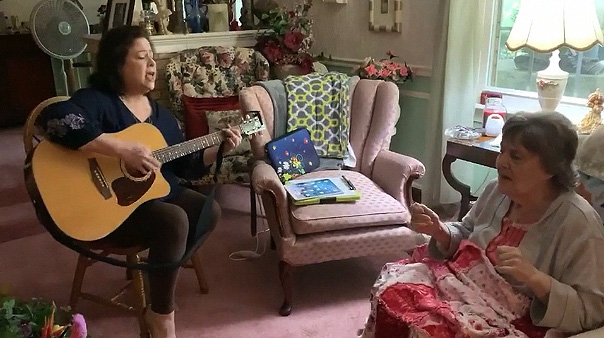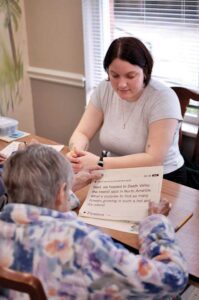By Tana Villanueva, general manager for VITAS® Healthcare
Peggy, a music therapist for VITAS Healthcare, strums a G major and lets the chord ring out. “I’m in love–I’m all shook up,” she sings, and she’s not the only one. VITAS patient Patricia, in her 80s and living with dementia, sings every word she remembers and mouths the handful she doesn’t.
Patricia sways, she claps, and her face makes it clear: She’s as happy as an Elvis superfan could be, barring a meeting with The King himself.
‘They Always Notice a Difference’
The heartwarming music therapy session, captured on video by one of Patricia’s caregivers, highlights the joyous power of this musical intervention. Music therapy isn’t right for every patient, but for many, it offers visible results surprisingly quickly.
“Whenever I go to meet Patricia, her caregivers will let me know whether she’s grumpy or down,” says Peggy. “They always notice a difference after her music therapy sessions. Her mood and her affect are brighter; she’s more pleasant and calmer.”
As with any hospice or palliative care intervention, music therapy is aligned to the diverse goals and wishes of each individual patient.
A music therapy care plan for a dementia patient such as Patricia, for instance, may focus on mood management and gentle sensory stimulation. For others, music therapy can encourage reminiscing, prompt creativity, or promote movement in patients with limited mobility.
Music With a Purpose
Music therapy also offers a chance for spiritual connection. For patients who can’t attend religious services—and during COVID-19, that’s nearly everyone—Peggy is happy to perform gospel songs and hymns. Often collaborating with a VITAS chaplain, she puts on a convincing inpatient liturgy for those who request it, giving her a chance to practice the skills she learned in church choir.
Playing and singing are just two ways Peggy uses music to connect with and comfort her patients. Depending on the patient’s needs, goals, and level of ability, she may help them write a song, improvise a melody, learn rhythm with percussion, or express their emotions and experiences using music as a medium.
Even when a session is more passive than interactive, Peggy is always assessing the patient’s response and calculating how best to help further. She also observes and engages with the surrounding loved ones, whose tireless work in the patient’s “circle of care” offers useful insight and sometimes warrants specialized care of their own.
“The caregivers are there with the patient all day long. They know her mood intimately, they get excited for her, and sometimes they become tearful as well,” Peggy says. “I think music therapy helps them deal with caregiving, which is very difficult—emotionally, mentally, and physically.”
Peggy says nothing demonstrates the palliative potential of music therapy like witnessing a session in person, but she does offer a succinct and poignant way to put her work into perspective: “Music therapy is music with a purpose.”
For more information about end-of-life care options, call VITAS Healthcare at 309.691.2381 or visit VITAS.com.










